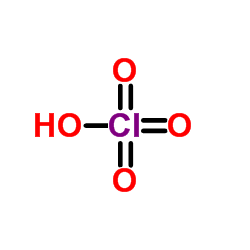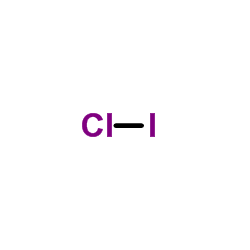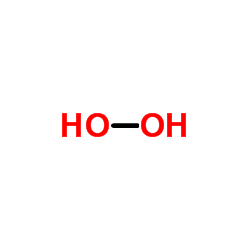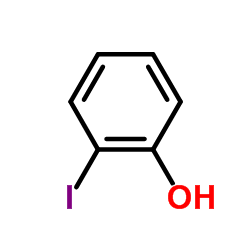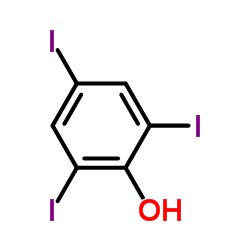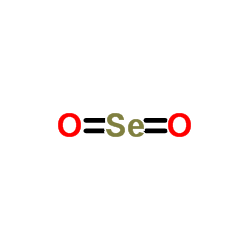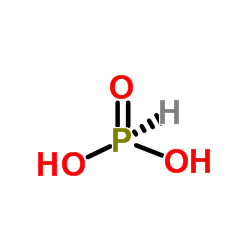7782-68-5
| 中文名 | 碘酸 |
|---|---|
| 英文名 | iodic acid |
| 英文别名 |
MFCD00011348
acid iodate Iodic acid trioxoiodic(V) acid Iodsaeure Iodic(V) acid hydrogen trioxoiodate Monoiodic acid hydroxidodioxidoiodine EINECS 231-962-1 |
| 密度 | 4.62 |
|---|---|
| 熔点 | 110ºC |
| 分子式 | HIO3 |
| 分子量 | 175.911 |
| 精确质量 | 175.897034 |
| PSA | 54.37000 |
| LogP | 0.47130 |
| 外观性状 | 白色晶体 |
| 折射率 | 1.95 |
| 储存条件 | 储存注意事项储存于阴凉、通风的库房。远离火种、热源。库温不超过30℃,相对湿度不超过80%。避免光照。包装密封。应与还原剂、醇类、易(可)燃物分开存放,切忌混储。储区应备有合适的材料收容泄漏物。 |
| 稳定性 | 1.稳定性 稳定 2.禁配物 强还原剂、醇类、易燃或可燃物、硫、磷、有机物 3.避免接触的条件 光照 4.聚合危害 不聚合 5.分解产物 碘化物 |
| 水溶解性 | 269 g/100 mL (20 ºC) |
| 计算化学 | 1.疏水参数计算参考值(XlogP):-0.3 2.氢键供体数量:1 3.氢键受体数量:3 4.可旋转化学键数量:0 5.互变异构体数量:无 6.拓扑分子极性表面积54.4 7.重原子数量:4 8.表面电荷:0 9.复杂度:46.2 10.同位素原子数量:0 11.确定原子立构中心数量:0 12.不确定原子立构中心数量:0 13.确定化学键立构中心数量:0 14.不确定化学键立构中心数量:0 15.共价键单元数量:1 |
| 更多 | 1.性状:无色斜方结晶,或有光泽的白色结晶。 2.熔点(℃):110(分解) 3.相对密度(水=1):4.63 4.溶解性:易溶于水、硝酸,不溶于乙醇、乙醚、乙酸、二硫化碳。 |
Synonym:Hydrogen Iodat Section 2 - COMPOSITION, INFORMATION ON INGREDIENTS
Risk Phrases: 34 8 Section 3 - HAZARDS IDENTIFICATION EMERGENCY OVERVIEW
Causes burns. Contact with combustible material may cause fire.Corrosive. Potential Health Effects Eye: Causes eye burns. May cause permanent corneal opacification. May cause chemical conjunctivitis and corneal damage. Skin: Causes skin burns. May cause skin rash (in milder cases), and cold and clammy skin with cyanosis or pale color. Ingestion: May cause severe and permanent damage to the digestive tract. Causes gastrointestinal tract burns. May cause perforation of the digestive tract. May cause systemic effects. May cause nausea, vomiting, and diarrhea, possibly with blood. Inhalation: Causes chemical burns to the respiratory tract. May cause systemic effects. May cause acute pulmonary edema, asphyxia, chemical pneumonitis, and upper airway obstruction caused by edema. Chronic: Effects may be delayed. Section 4 - FIRST AID MEASURES Eyes: Get medical aid immediately. Do NOT allow victim to rub eyes or keep eyes closed. Extensive irrigation with water is required (at least 30 minutes). Skin: Get medical aid immediately. Immediately flush skin with plenty of water for at least 15 minutes while removing contaminated clothing and shoes. Wash clothing before reuse. Destroy contaminated shoes. Ingestion: Do not induce vomiting. If victim is conscious and alert, give 2-4 cupfuls of milk or water. Get medical aid immediately. Inhalation: Remove from exposure and move to fresh air immediately. If not breathing, give artificial respiration. If breathing is difficult, give oxygen. Get medical aid. Do NOT use mouth-to-mouth resuscitation. If breathing has ceased apply artificial respiration using oxygen and a suitable mechanical device such as a bag and a mask. Notes to Physician: Section 5 - FIRE FIGHTING MEASURES General Information: As in any fire, wear a self-contained breathing apparatus in pressure-demand, MSHA/NIOSH (approved or equivalent), and full protective gear. Strong oxidizer. Contact with other material may cause fire. During a fire, irritating and highly toxic gases may be generated by thermal decomposition or combustion. Substance is noncombustible. Use water with caution and in flooding amounts. Oxidizer. Greatly increases the burning rate of combustible materials. Extinguishing Media: Substance is noncombustible; use agent most appropriate to extinguish surrounding fire. Contact professional fire-fighters immediately. Section 6 - ACCIDENTAL RELEASE MEASURES General Information: Use proper personal protective equipment as indicated in Section 8. Spills/Leaks: Avoid runoff into storm sewers and ditches which lead to waterways. Clean up spills immediately, observing precautions in the Protective Equipment section. Wear a self contained breathing apparatus and appropriate personal protection. (See Exposure Controls, Personal Protection section). Sweep up, then place into a suitable container for disposal. Avoid generating dusty conditions. Provide ventilation. Section 7 - HANDLING and STORAGE Handling: Remove contaminated clothing and wash before reuse. Minimize dust generation and accumulation. Do not get in eyes, on skin, or on clothing. Keep container tightly closed. Avoid contact with clothing and other combustible materials. Avoid ingestion and inhalation. Use with adequate ventilation. Discard contaminated shoes. Storage: Keep away from heat, sparks, and flame. Do not store near combustible materials. Do not store in direct sunlight. Store in a tightly closed container. Store in a cool, dry, well-ventilated area away from incompatible substances. Corrosives area. Section 8 - EXPOSURE CONTROLS, PERSONAL PROTECTION Engineering Controls: Facilities storing or utilizing this material should be equipped with an eyewash facility and a safety shower. Use adequate ventilation to keep airborne concentrations low. Exposure Limits CAS# 7782-68-5: Personal Protective Equipment Eyes: Wear appropriate protective eyeglasses or chemical safety goggles as described by OSHA's eye and face protection regulations in 29 CFR 1910.133 or European Standard EN166. Skin: Wear appropriate gloves to prevent skin exposure. Clothing: Wear a chemical apron. Wear appropriate clothing to prevent skin exposure. Respirators: Wear a NIOSH/MSHA or European Standard EN 149 approved full-facepiece airline respirator in the positive pressure mode with emergency escape provisions. Section 9 - PHYSICAL AND CHEMICAL PROPERTIES Physical State: Solid Color: white to pale yellow Odor: none reported pH: Acidic in solution. Vapor Pressure: Negligible. Viscosity: Not available. Boiling Point: Not available. Freezing/Melting Point: 230 deg F Autoignition Temperature: Not applicable. Flash Point: Not applicable. Explosion Limits, lower: Not available. Explosion Limits, upper: Not available. Decomposition Temperature: 230 deg F Solubility in water: 2.8 kg/L H2O @ 0C Specific Gravity/Density: 4.629 (water=1) Molecular Formula: HIO3 Molecular Weight: 175.9097 Section 10 - STABILITY AND REACTIVITY Chemical Stability: Stable under normal temperatures and pressures. Conditions to Avoid: Incompatible materials, light, ignition sources, dust generation, combustible materials, reducing agents. Incompatibilities with Other Materials: Reducing agents. Hazardous Decomposition Products: Irritating and toxic fumes and gases, iodine. Hazardous Polymerization: Has not been reported. Section 11 - TOXICOLOGICAL INFORMATION RTECS#: CAS# 7782-68-5 unlisted. LD50/LC50: Not available. Carcinogenicity: Iodic Acid - Not listed by ACGIH, IARC, or NTP. Section 12 - ECOLOGICAL INFORMATION Section 13 - DISPOSAL CONSIDERATIONS Products which are considered hazardous for supply are classified as Special Waste and the disposal of such chemicals is covered by regulations which may vary according to location. Contact a specialist disposal company or the local waste regulator for advice. Empty containers must be decontaminated before returning for recycling. Section 14 - TRANSPORT INFORMATION IATA Shipping Name: OXIDIZING SOLID, NOS Hazard Class: 5.1 UN Number: 1479 Packing Group: II IMO Shipping Name: OXIDIZING SOLID, NOS Hazard Class: 5.1 UN Number: 1479 Packing Group: II RID/ADR Shipping Name: OXIDIZING SOLID, NOS Hazard Class: 5.1 UN Number: 1479 Packing group: II Section 15 - REGULATORY INFORMATION European/International Regulations European Labeling in Accordance with EC Directives Hazard Symbols: O C Risk Phrases: R 34 Causes burns. R 8 Contact with combustible material may cause fire. Safety Phrases: S 26 In case of contact with eyes, rinse immediately with plenty of water and seek medical advice. S 28 After contact with skin, wash immediately with... WGK (Water Danger/Protection) CAS# 7782-68-5: 1 Canada CAS# 7782-68-5 is listed on Canada's DSL List. CAS# 7782-68-5 is not listed on Canada's Ingredient Disclosure List. US FEDERAL TSCA CAS# 7782-68-5 is listed on the TSCA inventory. SECTION 16 - ADDITIONAL INFORMATION N/A |
|
毒理学数据: 1.急性毒性 LD50:119mg/kg(小鼠腹腔) 2.刺激性 暂无资料 3.致畸性 频繁使用碘化物可致胎儿死亡,严重的甲状腺肿和甲状腺机能衰退,新生儿呈现克汀病样体征。 生态学数据: 1.生态毒性 暂无资料 2.生物降解性 暂无资料 3.非生物降解性 暂无资料
|
| 符号 |
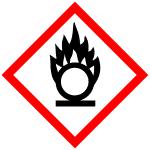

GHS03, GHS05 |
|---|---|
| 信号词 | Danger |
| 危害声明 | H272-H314 |
| 警示性声明 | P220-P280-P305 + P351 + P338-P310 |
| 危害码 (欧洲) | C:Corrosive |
| 风险声明 (欧洲) | R34;R8 |
| 安全声明 (欧洲) | S17-S26-S36/37/39-S45 |
| 危险品运输编码 | UN 3085 |
| WGK德国 | 3 |
| 包装等级 | II |
| 危险类别 | 5.1 |
| 上游产品 9 | |
|---|---|
| 下游产品 10 | |







